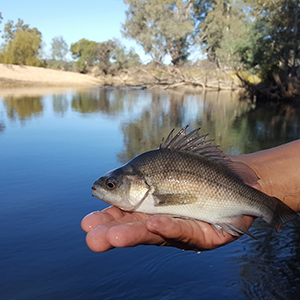Larval fish sensitivity to a simulated cold-water pulse varies between species and age

Accepted: 27 June 2022
Supplementary: 161
HTML: 135
All claims expressed in this article are solely those of the authors and do not necessarily represent those of their affiliated organizations, or those of the publisher, the editors and the reviewers. Any product that may be evaluated in this article or claim that may be made by its manufacturer is not guaranteed or endorsed by the publisher.
Authors
The release of cold-water from hypolimnetic zones of impoundments sharply reduces downstream riverine water temperature. This cold-water pollution (CWP) can extend for hundreds of kilometres, severely challenging the physiological ability of aquatic fauna, particularly ectotherms such as fish, to maintain essential processes such as metabolism, development and growth and survival. The impact of CWP on native fish, especially early life stages, is poorly known. We investigated the effect of a 24-hour exposure to a range of environmentally-related water temperatures (8, 10, 12, 14, 16, 18 and 20°C) on three age-classes (<24-hour-old, 7-day and 14-day-old larvae) of two Australian native fish species: Murray cod (Maccullochella peelii) and Macquarie perch (Macquaria australasica). Overall, larvae of M. peelii were more sensitive to lower water temperatures and hence CWP than M. australasica, indicated by higher rates of equilibrium loss. Larvae of M. peelii were most sensitive to exposure at seven days old whereas M. australasica larvae were most sensitive at <24-h-old. Using our results, we modelled pre- and post-impoundment temperature scenarios and estimated the downstream CWP footprint for both species in an Australian river reach. Larvae of M. peelii were predicted to be absent from the first 26 km of river downstream of the impoundment compared with no impact on the distribution of M. australasica. Managing riverine water temperature below impoundments is fundamental to promoting positive outcomes for endemic fish on not only a local, but global basis. This study emphasises the differential impact of CWP among the critical early life stages and fish species and highlights the urgent need to better manage hypolimnetic water releases to improve downstream river ecosystems.
Edited by
Pietro Volta, CNR-IRSA Verbania, ItalyHow to Cite

This work is licensed under a Creative Commons Attribution-NonCommercial 4.0 International License.
Similar Articles
- Franco GIOVANARDI, Richard A. VOLLENWEIDER, Trophic conditions of marine coastal waters: experience in applying the Trophic Index TRIX to two areas of the Adriatic and Tyrrhenian seas , Journal of Limnology: Vol. 63 No. 2 (2004)
- Ignacio GRANADOS, Manuel TORO, Recent warming in a high mountain lake (Laguna Cimera, Central Spain) inferred by means of fossil chironomids , Journal of Limnology: Vol. 59 No. s1 (2000): Climatic variability and ecosystem dynamics at remote mountain lakes
- Yoshimasa YAMAMOTO, Contribution of bioturbation by the red swamp crayfish Procambarus clarkii to the recruitment of bloom-forming cyanobacteria from sediment , Journal of Limnology: Vol. 69 No. 1 (2010)
- Valentina PIERI, Koen MARTENS, Fabio STOCH, Giampaolo ROSSETTI, Distribution and ecology of non-marine ostracods (Crustacea, Ostracoda) from Friuli Venezia Giulia (NE Italy) , Journal of Limnology: Vol. 68 No. 1 (2009)
- Valeria ROSSI, Carlo BELLAVERE, Giorgio BENASSI, Andrea GANDOLFI, Eletta B.A. TODESCHI, Paolo MENOZZI, Spatial segregation of Darwinula stevensoni (Crustacea: Ostracoda) genotypes in lentic and lotic habitats of Northern Italy , Journal of Limnology: Vol. 63 No. 1 (2004)
- Marco SIMONA, Winter and spring mixing depths affect the trophic status and composition of phytoplankton in the northern meromictic basin of Lake Lugano , Journal of Limnology: Vol. 62 No. 2 (2003)
- Roland SCHMIDT, Jens MÜLLER, Ruth DRESCHER-SCHNEIDER, Robert KRISAI, Krystyna SZEROCZYŃSKA, Ante BARIĆ, Changes in lake level and trophy at Lake Vrana, a large karstic lake on the Island of Cres (Croatia), with respect to palaeoclimate and anthropogenic impacts during the last approx. 16,000 years , Journal of Limnology: Vol. 59 No. 2 (2000)
- Kwang-Hyeon CHANG, Hideyuki DOI, Yuichiro NISHIBE, Shin-ichi NAKANO, Feeding habits of omnivorous Asplanchna: comparison of diet composition among Asplanchna herricki, A. priodonta and A. girodi in pond ecosystems , Journal of Limnology: Vol. 69 No. 2 (2010)
- Svein Birger WÆRVÅGEN, Jens Petter NILSSEN, Life histories and seasonal dynamics of common boreal pelagic copepods (Crustacea, Copepoda) inhabiting an oligotrophic Fennoscandian lake , Journal of Limnology: Vol. 69 No. 2 (2010)
- Roman Baran, Michal Tušer, Helge Balk, Petr Blabolil, Martin Čech, Vladislav Draštík, Jaroslava Frouzova, Tomáš Jůza, Jan Kubecka, Quantification of Chaoborus and small fish by mobile upward-looking echosounding , Journal of Limnology: Vol. 78 No. 1 (2019)
<< < 77 78 79 80 81 82 83 > >>
You may also start an advanced similarity search for this article.
-
John D. Koehn, Charles R. Todd, Henry Wootton, Michael JoyMarine and Freshwater Research : 2023

 https://doi.org/10.4081/jlimnol.2022.2056
https://doi.org/10.4081/jlimnol.2022.2056





